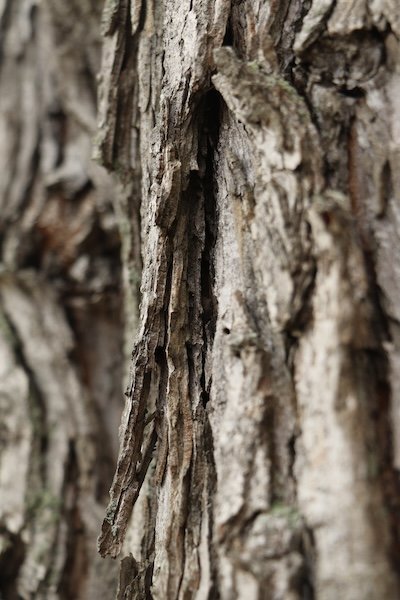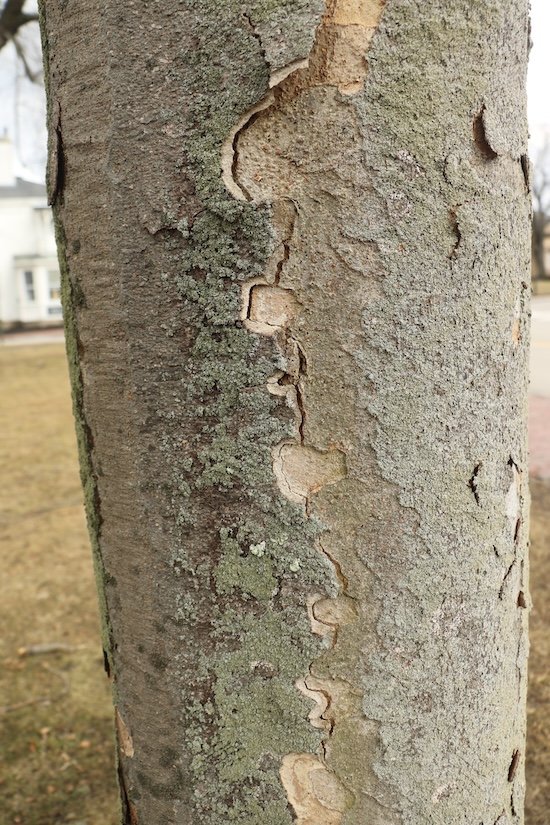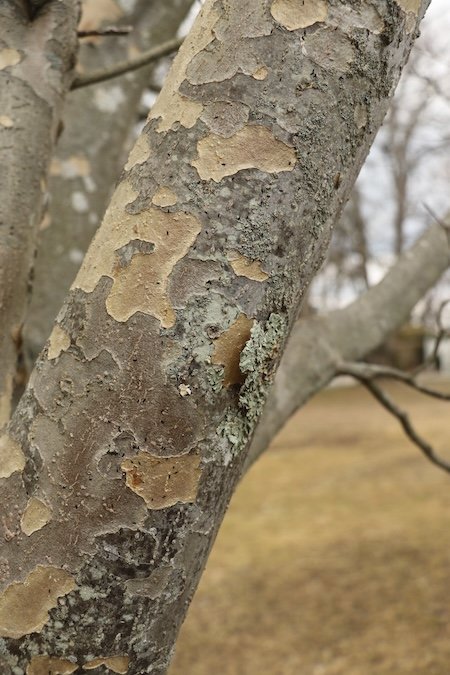Exfoliation: Uncovering the Beauty of Tree Bark in Winter
Winter, the season where change of any kind seems fleeting, and the passage of time halted. Unaided by the benchmarks of budburst and blooms, nature seems stalled, the outside world put on pause, but we know that soon the trees will grow again. Leaves emerge and turn our landscape green, branches stretch longer and reach for the sun, and though we can’t see them, we know roots weave their way through the earth, spurred on by spring rains. But even during the height of annual growth, the trunk, the steadfast pillar, seems immobile, unchanging. In theory we know it grows, gaining girth, creeping its way towards a size that puts it in our books as something notable, proof it has made it through our human needs and nature’s harshest storms. It is now, in the coldest season, where evidence of a trunk’s growth can be seen in the shapes and colors of its humble bark.
The purpose of bark is much like the purpose of our skin on those cold winter days, a protective layer that is stronger and more able to hold up against the harsh outdoor environment and the physical attacks it may endure, allowing the delicate processes that provide life to function within. The hard exterior also provides a more rigid structure, allowing trees to grow taller and stronger until their heartwood is sturdy enough to bear their weight. Along with this insulation, protection, and structure, bark harbors lenticels, porous tissues that allow for the exchange of air and moisture, that help the tree regulate itself through an otherwise hard exterior and prevent damage during seasonal changes. The lenticels also aid in carbon exchange, helping a tree withstand extreme conditions by allowing some limited bark photosynthesis, a process that keeps the tree’s internal functions running when leaves may become compromised.
The portion of the tree that grows each year is specifically the cambium cell layer, which is hypothetically a single layer of cells that run the circumference of the tree but can be difficult to distinguish from the transitional cells they produce, making the area easier to classify simply as the cambium zone. As the cambium grows, it produces xylem cells on its interior side, creating wood, and phloem cells on the outside, creating an inner bark layer. These plant tissues are responsible for the transportation of water and nutrients throughout the tree. On the outside of this phloem layer is the periderm, the first layer of outer bark, a continuous hard shell that is not broken as it encompasses the tree, it is the smooth bark that is visible on young trees and branches. With each season of growth, the new year’s active phloem and periderm layer regrow and expand under the previous year’s growth. The alternating layers of now dead phloem and periderm pile up and, no longer able to remain intact, begin to crack, split, and peel, giving each species of tree its unique appearance with its most visible layer called the rhytidome.
Silver Maple (Acer saccharinum) – The thick exfoliating layers of this silver maple in Touro Park allows us to see the layers of rhytidome as they peel away from the trunk.
Just as notable as the differences caused by this process, are the ones that are not. The American beech (Fagus grandifolia) is an example of a tree that does not shed its bark. Instead, its slow, steady growth allows the periderm to grow with the trees, giving it its signature smooth bark which in turn, allows for the initials of lovers long past to remain carved into the trunks of ancient trees, growing with age. This slow and smooth growth strategy enables the beech to maintain good defenses against fungi and epiphytes like English ivy (Hedera helix), but also makes it harder for the tree to recover once damage is done.
American Beech (Fagus grandifolia) – The once clear and smooth bark of most American beeches here in southern New England have become marred with frost cracking and weakened by beech leaf and bark disease.
European Beech (Fagus sylvatica) – Initials carved into the once smooth trunk of a weeping European beech that have healed and grown with the trunk of the tree.
Now, for those trees whose bark does not grow along with them, part of their growing process is for their bark to shed, with the outermost layers of rhytidome flaking off as connections to the lower layer weakens. This process is called exfoliation. While bark exfoliation happens throughout the year, certain conditions increase the rate at which it occurs, particularly in the winter and spring. Sudden cold and frost conditions cause the contraction of bark pieces and fluctuations in the shape and size of any water that may be within the tree’s structure, contributing to more consistent and rapid exfoliation. It should be noted that bark falling from trees has the potential to be an indicator of a tree’s health, and more often than not this can be a person’s first reaction to noticing the phenomena of exfoliation. The difference between sick and healthy bark loss can be seen in other signs of decline exhibited by the tree and the health of the state of the bark revealed by the exfoliation, weather it is fresh and solid or shows signs of a crumbling interior.
What makes exfoliation something to be admired and appreciated, is the change in color that comes with it. An unexpected example is the Japanese Zelkova (Zelkova serrata), an oft planted street tree prized for its densely branching vase-like shape and deep green leaves. What is not always notable is its sandpapery, brown-grey bark, and for that reason it might be easy to glance over its winter colors, where map-like pieces shed from the trunk to reveal shades of green and orange. The colors come from the different layers in the outer bark, which includes the active periderm cork layer, with splashes of green coming from remaining chlorophyll. Once exposed to the elements and the cambium continues its interior growth, the bark will once again fade to grey as the active periderm is replaced within and becomes inactive rhytidome.
Japanese Zelkova (Zelkova serrata) – This tree exhibited an interesting zipper-like beginning to its exfoliation, thick pieces cracking away from each other in the sun of the south facing side of this zelkova in Touro Park.
One of the most striking changes can be seen in a formidable native tree, the American sycamore (Platanus occidentalis). While not as showy at eye level where the trunk remains covered in a thick, furrowed grey bark, if you look up into the canopy there is a shock of pure white that runs along its upper branches that is particularly stunning against a clear blue winter sky, or a sky darkened with the slate grey nimbostratus clouds of an impending snowstorm. A large example grows on Barney St, behind the Newport Historical Society, with its beautiful, rugged bark at its base smoothing as it climbs the trunk, where it is just beginning to reveal bone white branches at its pinnacle.
American Sycamore (Platanus occidentalis) – A beautiful example of an American sycamore growing in Swan Point Cemetery, photographed by Joe Verstandig.
A cross between P. occidentalis and P. orientalis, the London planetree is ubiquitous in Newport, lining boulevard, street, and lawn border alike. The horticultural benefit to a London Planetree compared to our straight native species, in addition to their resistance to anthracnose, is the retention of these exfoliating bark features down the whole of its trunk, even when the tree reaches old age. There are several spectacular examples of these trees throughout Newport, some of the largest being the line on Kay St with the most magnificent bordering the parking lot to Braga Park with other large notables can be found on Mill St east of Corne St, and on Gibbs Ave near north of the Bliss Rd corner.
London Planetree (Platanus x acerifolia) – One of the many examples found throughout Newport sporting its crinkle edged exfoliation.
On the opposite end of the scale of commonality is the lacebark pine (Pinus bungeana). Found few and far between in Newport, this evergreen, native to central and eastern China, has luscious dark green needles in addition to its namesake, making it a notable addition to any winter landscape. Recently, one of the few examples was featured by our Living Collections Manager as tree of the week. The oldest bark maintains a green-grey hue that exfoliates in puzzle-like pieces to reveal deep yellows and greens not dissimilar to the rinds of lemons and limes.
Lacebark Pine (Pinus bungeana) – Another photograph by Joe Verstandig exhibiting the citrus rind texture and colors of the lacebark pine.
The kousa dogwood (Cornus kousa), while planted and noted for their cheerful late spring colors, has a flaking bark not dissimilar to the zelkovas but coming off in smaller, thinner chips. The variations in their bark can be seen in Touro Park, along the short path that is lined with them on the western side of the park. Another small tree with a similar chipping pattern to its bark is the Persian ironwood (Parrotia persica). The differences lie in the color variation for these two, with the parrotia bringing more of a chocolate chip cookie dough to mind with its rich cinnamon brown bark flaking off to reveal a smooth malt beige beneath. This exfoliation pattern can be seen on two large examples in town, one in the garden border beside the black and gold 421 Bellevue sign visible while waiting at the Narraganset traffic light, and the second tucked behind the stone wall at St. Michaels along Rhode Island Ave.
Kousa Dogwood (Cornus kousa) – The chipping bark of a kousa dogwood in Touro Park harboring the small black insects known as springtails.
Persian Ironwood (Parrotia persica) – This multi-stemmed example
at URI shows off the chocolate chip nature of its exfoliating bark.
Now the bark of a Japanese stewartia (Stewartia pseudocamellia) is something to behold year-round, but a greater appreciation for its smooth texture and calico patterns can be had in the winter, when there is nothing to block the sun’s rays from shining on its satin bark. Colors vary from tree to tree and cultivar, but they are all stunning. Stippled grey bark gives way to an array of copper, bronze, and silver accompanied by tinges of green and more humble browns and greys. If a kousa exfoliates like puzzle pieces, the stewartia shows its colors in rounded paint splatters and smears running down its trunk, patterned like a sun dappled forest though there are no leaves above. While uncommon in public spaces in Newport, one example can be found in Aquidneck Park planted to the right of the steps up to the Edward King House. A collection of seven recently planted stewartias can be found planted in the plots near the entrance to Island Cemetery, a location to watch as they grow to be a stunning grove.
Japanese Stewartia (Stewartia pseudocamellia) – Three examples of the variation in
color and exfoliation shapes that can occur between different stewartia trees and their cultivars.
The final trees of note here have the unique exfoliation pattern of peeling, that, in combination with their bright colors, make them stand out in the contrast of winter. The paperbark maple (Acer griseum), paper birch (Betlua papyrifera), and river birch (B. nigra), each have thin, peeling bark that rolls like parchment across their trunks. These trees are always a lovely addition to a winter garden, particularly when the maple is placed on the south side of a path or sight line to take advantage of the low winter sun that catches the exfoliating bark and shines through creating a halo of tangerine stained glass. A pair on Boughton road illustrate their street tree potential and show off the thin peeling bark that gives the tree its name. Both birches exhibit their bark in Miantonomi park, where a beautiful grove of river birches was planted in 2021 and some of the largest paper birches grow wild on the hill, their white bark somehow becoming more heightened by the season’s snowfall.
Paperbark Maple (Acer griseum) – The unique orange-brown of paperbark maple peels to reveal the fresh and vibrant hues of the next year’s exterior protection, rolling back in small tight curls.
Paper Birch (Betula papyrifera) – Beautiful, paper thin peels of bone white bark reveal a lovely cream-colored interior that stands out against winter landscape and dark eyes of the tree’s branching nodes.
River Birch (Betula nigra) – The river birch, particularly the cultivar Heritage, is unique in the sheer number of layers of bark that builds up like piles of old parchment paper clinging to its trunk.
While this winter has been harsh, the snow, ice, and clear blue skies that follow accentuate Newport’s urban forest at its barest. At no other time is a tree’s sculptural beauty more visible. Sturdy trunks taper off into slender branches and delicate twigs that sway in the seemingly endless wind sweeping across the bay. With no leaves, flowers, or fruits to distract the eye, the beauty of the bark itself is on full display. For all the trees not mentioned here, whose bark isn’t as eye-catching, winter remains the perfect opportunity to go out and appreciate this oft-forgotten feature. Look a little closer, see the layers of rhytidome pushing up and out, cracks, splits, and peels, released by the pressures of growth. Find the camouflaged insects nestled into even the tiniest of crevices, hunkered down, waiting. Notice the lichens gently clinging to the outermost layers of aged bark in trepidation of exfoliation and encircling the periderm of young twigs in the canopy. Take the time to admire the forms of the trees we care for and depend on in their barren time of rest, if only so the phenomena of life and growth can be appreciated all the more come spring.
By Morgan Palmer — Plant Production Manager
To learn about what trees and shrubs are blooming in the winter check out this video by Living Collections Manager Joe Verstandig.
Winter Flowering Trees and Shrubs
Citations
Rosner, S., & Morris, H. (2022). Breathing life into trees: The physiological and biomechanical functions of lenticels. IAWA Journal, 43(3), 234–262.
Wojtech, Michael. Bark: A Field Guide to Trees of the Northeast. University Press of New England, 2011.

















